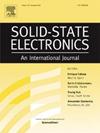Direct extraction of parasitic source and drain resistances in MOSFETs using saturation current ratio
IF 1.4
4区 物理与天体物理
Q3 ENGINEERING, ELECTRICAL & ELECTRONIC
引用次数: 0
Abstract
We propose a saturation current ratio technique (SCRT) for the separate extraction of parasitic source and drain resistances (RS and RD) in metal–oxide–semiconductor field-effect transistors (MOSFETs). Unlike conventional methods that require multiple devices or prior knowledge of device parameters, SCRT enables accurate characterization of parasitic resistances using a single device through simple DC measurements. The technique employs a dual configuration by alternating the roles of the source and drain during forward and reverse measurement sweeps. By analyzing the ratio between the drain saturation currents measured in each configuration, SCRT effectively separates RS and RD by quantifying their individual contributions to the voltage drop across the source and drain terminals. Experimental validation on both n-channel and p-channel MOSFETs with various channel lengths and widths confirms the robustness, accuracy, and reproducibility of the proposed method. SCRT offers a practical and efficient approach for characterizing asymmetric parasitic resistances in individual devices, making it a reliable alternative to conventional extraction techniques.
利用饱和电流比直接提取mosfet中的寄生源极和漏极电阻
我们提出了一种饱和电流比技术(SCRT),用于分离提取金属氧化物半导体场效应晶体管(mosfet)中的寄生源极和漏极电阻(RS和RD)。与需要多个器件或器件参数先验知识的传统方法不同,SCRT可以通过简单的直流测量使用单个器件准确表征寄生电阻。该技术采用双重配置,在正向和反向测量扫频期间交替作用源和漏极。通过分析在每种配置中测量的漏极饱和电流之间的比率,SCRT通过量化它们对源极和漏极两端电压降的单独贡献,有效地分离了RS和RD。在不同沟道长度和宽度的n沟道和p沟道mosfet上进行的实验验证证实了该方法的鲁棒性、准确性和可重复性。SCRT为表征单个器件中的不对称寄生电阻提供了一种实用而有效的方法,使其成为传统提取技术的可靠替代方案。
本文章由计算机程序翻译,如有差异,请以英文原文为准。
求助全文
约1分钟内获得全文
求助全文
来源期刊

Solid-state Electronics
物理-工程:电子与电气
CiteScore
3.00
自引率
5.90%
发文量
212
审稿时长
3 months
期刊介绍:
It is the aim of this journal to bring together in one publication outstanding papers reporting new and original work in the following areas: (1) applications of solid-state physics and technology to electronics and optoelectronics, including theory and device design; (2) optical, electrical, morphological characterization techniques and parameter extraction of devices; (3) fabrication of semiconductor devices, and also device-related materials growth, measurement and evaluation; (4) the physics and modeling of submicron and nanoscale microelectronic and optoelectronic devices, including processing, measurement, and performance evaluation; (5) applications of numerical methods to the modeling and simulation of solid-state devices and processes; and (6) nanoscale electronic and optoelectronic devices, photovoltaics, sensors, and MEMS based on semiconductor and alternative electronic materials; (7) synthesis and electrooptical properties of materials for novel devices.
 求助内容:
求助内容: 应助结果提醒方式:
应助结果提醒方式:


